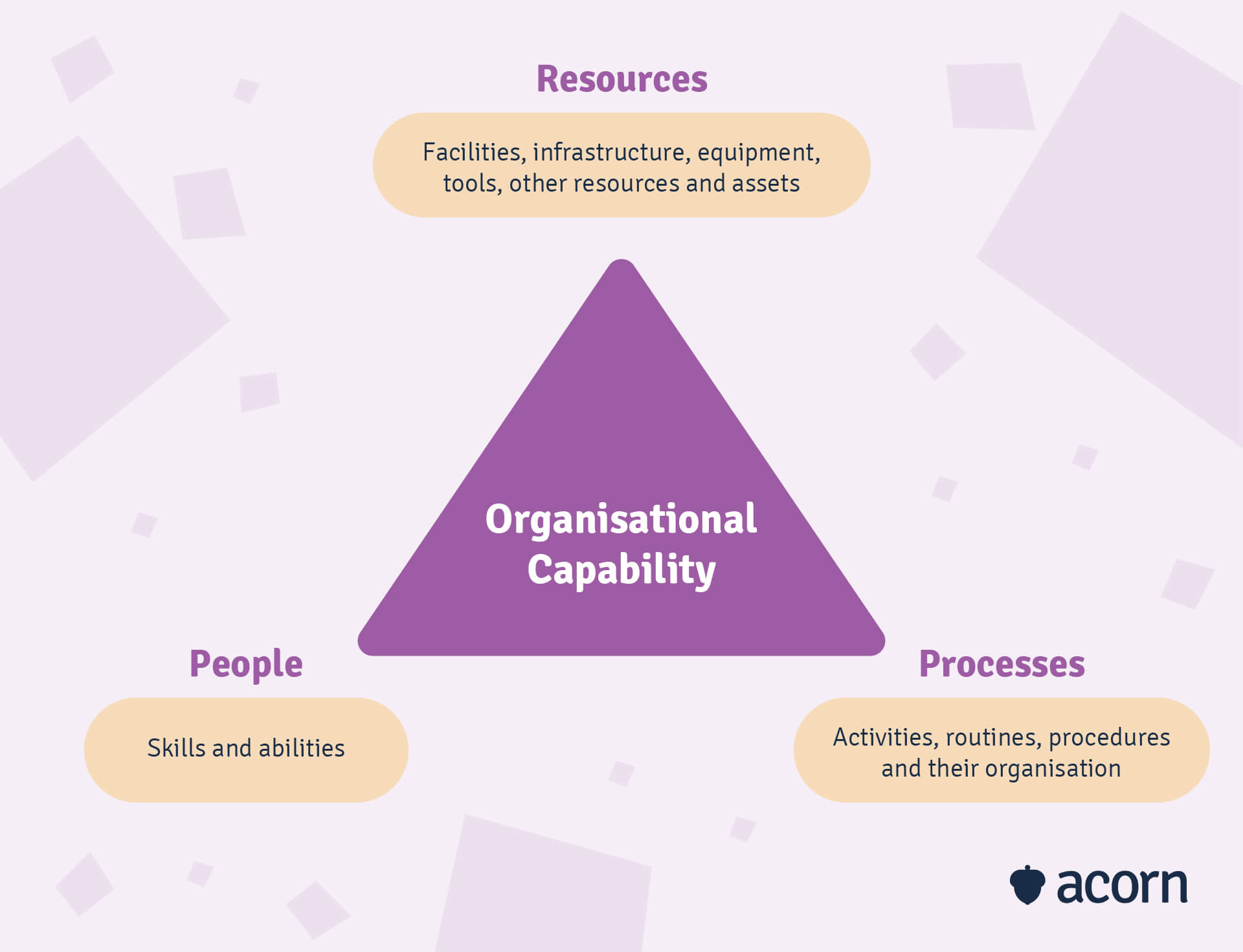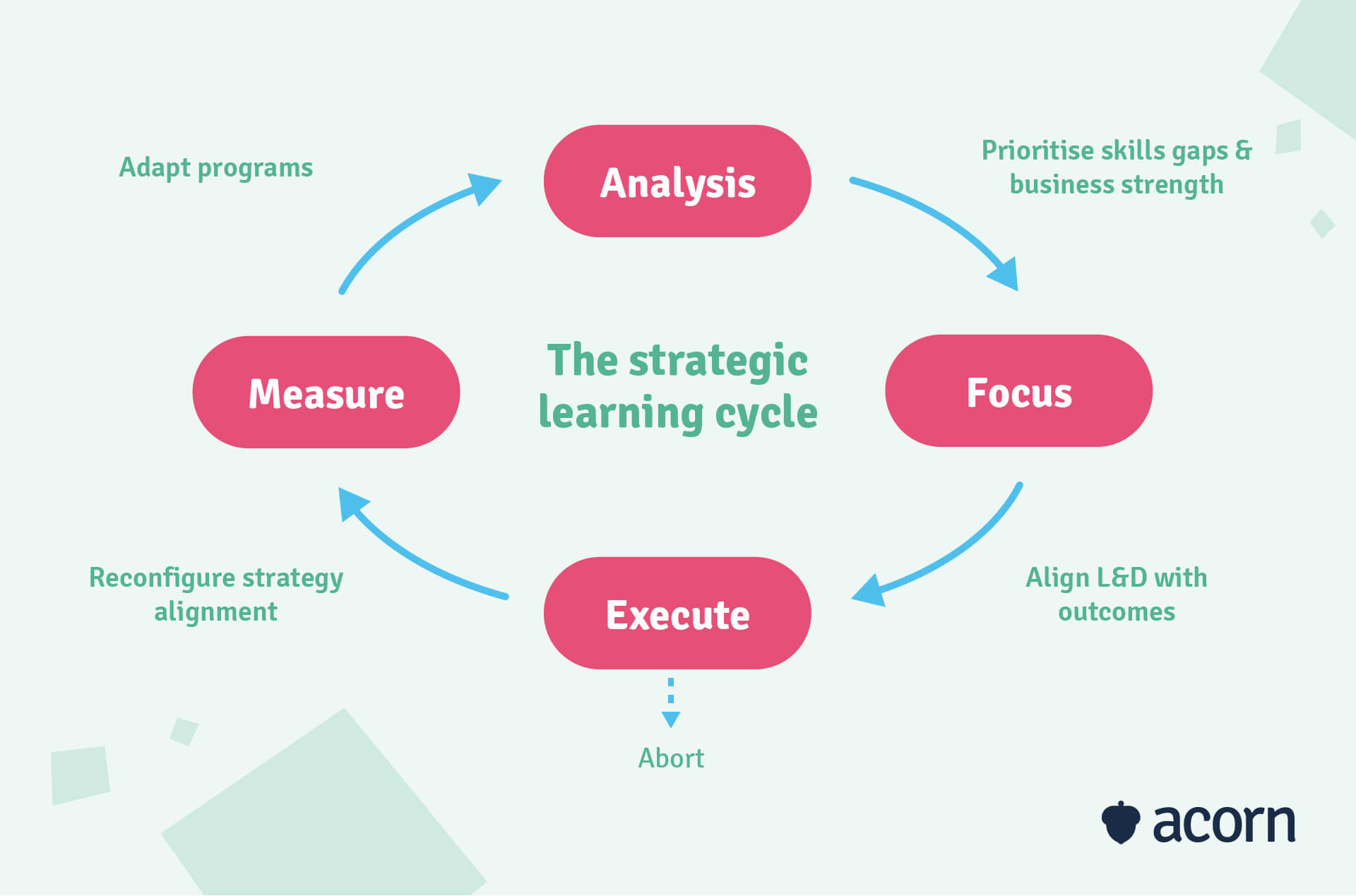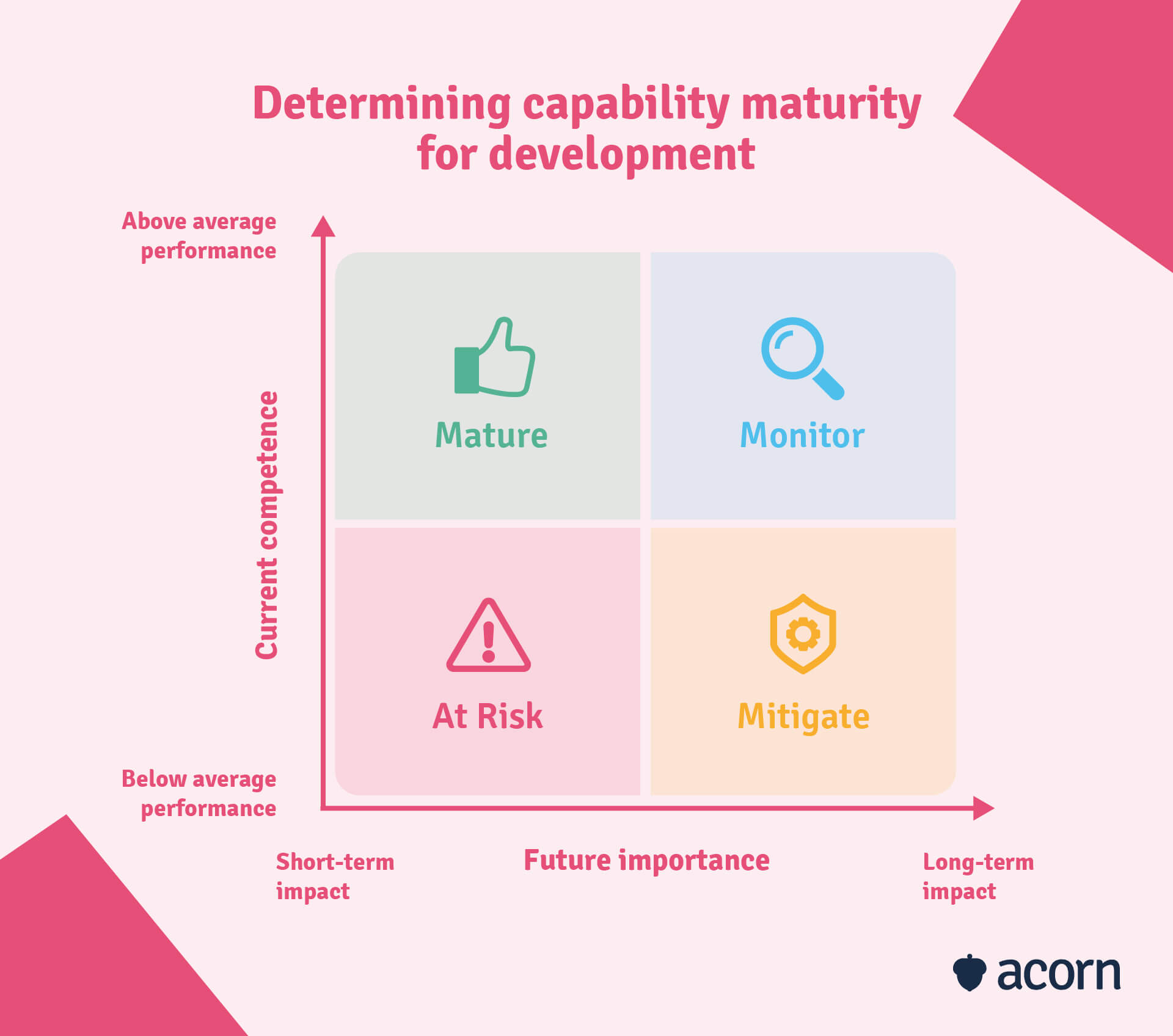Creating an Organisational Capability Framework

And how to use strategic learning to continuously develop crucial capabilities.
Creating an Organisational Capability Framework: Why Strategic Learning is an Important Step
Organisational capability frameworks can be used as a pathway to success by businesses, but you need to give employees the know-how to drive this success.
Strategic learning helps tie capabilities into professional development while also giving L&D teams the insights needed to continually optimise training for employees and business. Seem daunting? Don’t worry. We’re about to break down exactly how to align your organisational capabilities with a strategic learning approach.
What is an organisational capability framework?
An organisational capability framework outlines the capacity, skills, knowledge and behaviours needed to successfully meet a company’s specific objectives. It creates a common language of expected behaviours across teams, as well as providing a basis for resourcing and workforce planning, L&D and organisational development activities.
What are organisational capabilities?
Think about the collective skills, abilities and knowledge you possess. Compare that with what your coworkers know. Even if there’s crossover, your abilities are defined and moulded by how you do or don’t use them. That’s why even though someone can do what you do, rarely can anyone replicate exactly how you do it.
It’s the same thing (on a much larger scale) for organisations. Organisational capabilities comprise the skills, knowledge, activities, information, processes, staffing, systems and technology that a specific organisation depends on. Organisational health and strength lies in how these are aligned with business strategy.
The defining features of organisational capabilities include that they:
- Are difficult to replicate
- Shape competitive advantage
- Drive continual business success
- Meet pressing economic challenges
- Address forecasted scenarios
- Align behaviours (often seen as tangential and intangible) with business architecture and processes.

Today’s CEOs have shifted their focus to using capabilities as a differentiator. In this instance, we are defining a capability as a critical combination of knowledge, skills, tools, processes and behaviours that deliver an organisational objective. And those companies with a capability-driven strategy are three times as likely to grow faster than their industry, 2.5x as likely to be more profitable than the market, and make deals that generate 14 percentage points more in annualised TSR.
What does it mean to build organisational capability?
Organisational capabilities give your organisation a base for strategic workforce planning and business planning, as well as any other operational endeavours your organisation explores.
That’s more than just gaining competitive advantage. An organisational capability framework helps:
- Plug the risks associated with changes in the environment, industry or business structure.
- Create a universal language and market for strategic issues, specifically by transforming organisational concerns into individual actions. (This is a top-down problem, too, not one employees need to or even can reconcile.)
- Clearly define competitive differentiators, operational necessities and strategic drivers.
- Keep success sustainable. A stable reference for business architecture is invaluable when facing economic and environmental disruptions.
So, building organisational capability means you know your fundamental strengths and weaknesses, including any fluctuations in business performance, and offers valuable insights into where to direct resources.
Capabilities are also a gauge of your organisation’s potential to perform. Private enterprise frameworks are often designed to be stable, with little need for anticipated change. This is because:
- Any strategic capabilities you have now should continue to meet strategic objectives in future.
- The key capabilities that define success for you now can be expected to drive future success, too.
And not only does this fortify strategic planning in an unpredictable business environment, but it can provide a focus for business-aligned learning and development activities.
Organisational capability examples
There are many ways to typify capabilities for your organisation. While we’ve said your capabilities should be unique to your environment, there are some general ways to break down your value chains.
- Operational: The core, customer-facing operations that give you your competitive advantage. You can’t outsource these as they often require the most resources. Think marketing, sales and product, like marketing automation, customer connectivity and product quality, respectively..
- Strategic: What sets your business apart in its environment? These capabilities exploit opportunities, neutralise risk and affect you long-term, such as performance management and risk analysis.
- Supporting: You can have two kinds of supporting capabilities. First, those that support the business, like human resources management. Second, any operations or processes that you engage third parties to handle.
- Contextual: Lesser known and “behind the scenes”. These are usually lower-level capabilities with more intangible value, mainly apparent when they don’t work well. Payroll and soft skills like effective communication are examples.
What is strategic learning?
What makes capabilities inimitable is often a combination of time crunch and the path taken to develop them. Like coworkers trying to emulate your skillset, your competitors would need to follow the same path of internal learning to replicate what you do—but of course, that’s not possible, as your learning and development process will be tailored to your priorities, investments and capability needs. Or at least it should be, if you utilise strategic learning.
This is a dynamic approach to learning and development that shapes learning programs with insights from your internal and external environments, ultimately adapting them to meet changing business and employee needs. Strategic learning also integrates evaluation into the learning culture to continually create and implement strategies that drive an agile organisation.
There are two benefits of tying strategic learning to capability frameworks:
- You’re looking at capabilities as a dynamic learning resource.
- It gets you to look at continuously upgrading, nurturing or even abandoning them as suits your needs.

Step 1: Analysis
At this stage, you’re gathering insights that form the basis of any strategic choices. This is where competitive advantage begins.
As Willie Pietersen puts it, you’re trying to create asymmetry between you and your competitors by gaging the market, customers and competition better than the competition themselves. This is as much about looking inwards as it is an external retrospective. The aim is to understand your external environment against your internal realities to determine your most optimal future direction.
If that’s clear as mud, some guiding questions here include:
- What are the trends in customer expectations?
- What is their hierarchy of values?
- How well are competitors serving those needs?
- What trends are shaping our industry?
- How do these trends shape the parameters of success?
- What threats do these trends present to our business model?
- What trends can we see in our performance over the last five years?
- What are our strengths (profit makers) and weaknesses (barriers)?
Tip: How to choose capabilities for development
For some organisations, looking inwards can be the harder part of an environmental scan. Heatmapping is one way you can easily determine what’s at risk in your organisation, thereby needing immediate attention.

In its simplest form, heatmapping prioritises capabilities by risks to their performance. Low utilisation, lack of resources and business value are all rationales for judging the health of a capability.
Keep in mind that prioritisation isn’t an exercise in playing capability favourites. If anything, it’s a way to justify resourcing in a language that senior executives (aka those who impact workforce buy-in) can understand.
This is also where L&D teams can seek to better understand a day in the life of employees when determining capabilities for development, either as part of a workforce scan or separately. Consider:
- What is an individual good at and why?
- What do they enjoy doing and why?
- Where is that combination most valued and best used?
- What skills does the industry need right now and what skills do we need in response?
Step 2: Focus
Your environmental scan uncovers the issues you’re facing, potential issues you could face in future, schemes for addressing those issues and what sets you apart from competition. Both your strengths and capability gaps give you the skills and behaviours you want to focus on developing.
So, now we have workforce data, industry insights and capability requirements, we can define key deliverables (or strategic orientation) for learning programs.
Consider employee needs alongside business drivers as this will give you better clarity on the content and design of a learning program. While the goal is to evolve this as needed, your basis for learning will always be meeting the capability requirements of your organisation.
A key point here is to define technology and supporting resources, such as a performance learning management system and eLearning material. This is important as the delivery of learning is core to eventually quantifying impact.
The following can be helpful prompts when weighing up digital learning modes.
- How often do our employees learn during the flow of work? Is this impacted by the technology available to them?
- What drives or triggers learning? E.g. Challenging tasks, curiosity or insufficient knowledge.
- Are there any bottlenecks in business processes? Are employees overwhelmed by information? Is access to knowledge lacking? Do employees even have enough time to learn?
- What solutions do employees currently use to address their learning needs? (YouTube is the most popular informal educational platform in the world, FYI.)
- How do employees engage with their peers and/or managers when they need help?
- What job roles are considered critical now and into the future, and how do available capabilities match those?
Tip: Match skills and tools to behaviours
It can be easy to focus solely on technical business drivers when developing capabilities. Yet research by Boston Consulting Group shows that behaviours are often more important than business functions when creating an agile business structure.
Consider that simply introducing new systems does not make an organisation excellent. The gap between implementation and realisation is practice, and practice comes down to employee performance (and employee performance will directly impact business performance). You need to be putting the effort into ensuring employee behaviours match business needs.
Leadership development, as an example, develops crucial skills that—without a defined capability strategy or framework—are largely intangible assets. Senior leaders in particular influence, delegate, prioritise and translate strategy into everyday work. Yet leadership deficits form when:
- Budding talent is left unnurtured (because talent itself rarely makes the leader).
- Companies focus solely on core capabilities over agile behaviours that underpin other crucial capabilities.
Capability building that focuses on behaviours and is based on future needs enables that dynamic learning you’re after. Look at change management and emotional intelligence. Possessing them alone won’t achieve competitive advantage. But if you design programs to develop them as support for core capabilities (think innovation, culture and product development), you can create the sustainable, strategic value your organisation needs.
Step 3: Execute
Now planned, strategy can be implemented. Establishing a focus means that employee training is fit for purpose for both individuals and the organisation.
Implementation is then smoother, since you’re accounting for nuances in workplace culture and business architecture. You’ve also cherry-picked the supporting assets and tools that, with the information available to you, will help employees engage better with learning strategies.
There are a couple of side-quests involved in learning strategy execution. The first is setting the climate for learning. This can be bolstered through a second aim of continuing to experiment with and probe learning as it happens.
On the latter point, it means that you can watch for emergences. If a certain program is popular, you’ll want to amplify those positive effects. But if something is not delivering benefits or just not delivering at all, it means you can write off an initiative that doesn’t work for you.
Being too focused on a fixed process in the name of efficiency can inhibit this process of experimentation and force you to inadvertently follow an ill-fit path. Focus your efforts on effect just as much as efficiency in the learning process.

Keep in mind that the goal of experimentation is to continually collect data on:
- Efficacy of learning (through defined learning outcomes)
- Completion rates
- Engagement rates
- Cost per course or facilitator (if you’re using third-party providers)
- Learner experience
- User experience (if you’re using ed tech).
Step 4: Measure
This is the step that actually starts the learning loop. Reporting analytics are a useful tool, especially if using an LMS or other ed tech. Surveys are also handy for ascertaining individual sentiments at different phases of the learning process.
But perhaps the most effective way to measure the impact of L&D is through performance management and talent management. After all, building capabilities is an exercise in organizational resilience—which should mean driving business performance through behavioural change. This can be trickier as you’re not just looking at numbers, but performance indicators. And here we come full circle back to organisational capability frameworks.
Keep in mind that capabilities are learned over time. You can’t do one learning cycle and expect all employees to be highly competent in all capabilities. That’s not how a dynamic process works, and it also prevents you from being able to accurately review the true business impact of capabilities. (If it only took one go to be an expert in something, we’d be shredded after one workout.)
Finally, Step 4 is where you update your initial insights or even your methods of examination. What you’ve learned from this cycle (even if it’s just the way in which capabilities have evolved) may provoke a new environmental scan, which takes you back to Step 1 and onto the path to continuous improvement.
Key takeaways
Don’t think of learning as a one-way street that starts at A and ends at B. If you’re truly trying to realise business impacts, you need to tie your organisational capability frameworks to L&D.
What makes your organisation competitive and unique (cough, capabilities, cough) doesn’t just magically appear. You can develop capability in your employees if you consider a dynamic strategic learning approach. This involves constantly assessing delivery, materials and impact to ensure employees are meeting organisational objectives designed to support business success.